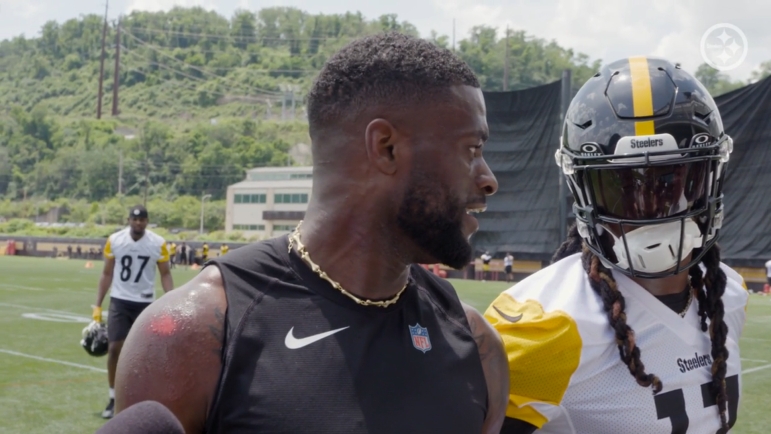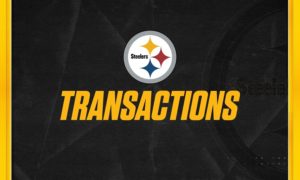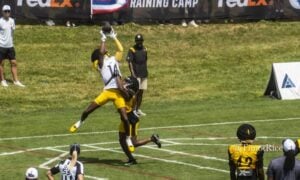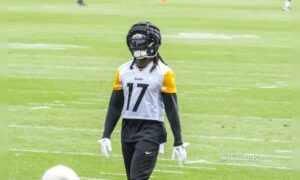Player: WR Marquez Callaway
Stock Value: Up
Reasoning: The Steelers have not done a great deal to address the wide receiver position, beyond some token moves. After trading Diontae Johnson, they have no established starter behind George Pickens. That plays to the advantage of a veteran like Marquez Callaway (pictured in a helmet next to Van Jefferson), who is trying to find a spot in Pittsburgh.
If Marquez Callaway is seeing 50-plus targets this season, the Steelers are probably in trouble. But considering the alternatives, they are quite frankly in danger of doing worse. Right now, they only have one established starter in George Pickens surrounded by a bunch of “guys”.
Callaway is one of those “guys” just about as much as anybody else. A veteran of four seasons with the New Orleans Saints, he does have over 1,500 snaps’ worth of experience. He has 83 catches to his name for 1,069 yards and 7 touchdowns. By far his most extensive playing time came in 2021, during which he caught 46 passes for 698 yards and 6 touchdowns.
But that is two years removed, and he has done little since. Callaway only dressed for three games last year, for example, and never saw a target. He spent much of that season on the practice squad and signed with the Steelers on a Reserve/Future deal at the end of the year.
Marquez Callaway lacks the speed you want in a wide receiver, but he does have size. And with it looking like Brandon Aiyuk isn’t coming to town, he is as good as the next guy. The depth receiver with the highest upside of rookie third-round pick Roman Wilson, but he is as yet unproven. Van Jefferson, Quez Watkins, and Scotty Miller have comparable resumes.
Since the draft, the Steelers have done next to nothing to address the wide receiver position. Perhaps they still make a trade in the future, but probably not before training camp. Guys like Callaway can convince them that they don’t need outside help by stepping up.
As the season progresses, Steelers players’ stocks rise and fall. The nature of the evaluation differs with the time of year, with in-season considerations being more often short-term. Considerations in the offseason often have broader implications, particularly when players lose their jobs, or the team signs someone. This time of year is full of transactions, whether minor or major.
A bad game, a new contract, an injury, a promotion—any number of things affect a player’s value. Think of it as a stock on the market, based on speculation. You’ll feel better about a player after a good game, or worse after a bad one. Some stock updates are minor, while others are likely to be quite drastic, so bear in mind the degree. I’ll do my best to explain the nature of that in the reasoning section of each column.








